



Hiroshima and Nagasaki Bombing Timeline
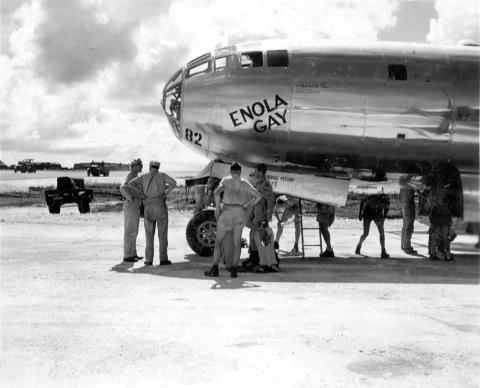
Enola Gay, the B-29 that dropped Little Boy on Hiroshima.
Preparations
July 16:
The "Gadget," an plutonium implosion device, detonates successfully in the Trinity test at Alamogordo, NM, demonstrating that the Fat Man atomic bomb design will work.
Little Boy bomb units, accompanied by the U-235 projectile, are shipped out of San Francisco on the USS Indianapolis for Tinian Island.
July 20:
The 509th Composite Group begins flying practice missions over Japan.
July 21:
President Harry Truman receives report on the successful Trinity test.
July 23:
Secretary of War Henry Stimson, in Potsdam for meeting between President Truman and Soviet Premier Stalin, receives current target list. In order of choice it is: Hiroshima, Kokura, and Niigata. He also receives an estimate of atomic bomb availability: Little Boy should be ready for use on Aug. 6, second Fat Man-type by Aug. 24, 3 should be available in September, and more each month - reaching 7 or more in December.
Combat hemispheres for Fat Man are fabricated at Los Alamos.
July 24:
General Leslie Groves drafts the directive authorizing the use of the atomic bombs as soon as bomb availability and weather permit. It lists the following targets in order of priority: Hiroshima, Kokura, Niigata, and Nagasaki. This directive constitutes final authorization for atomic attack; no further orders are issued.
The U-235 target for Little Boy is cast at Los Alamos.
July 25:
Peer de Silva, the official courier for the Fat Man core, signs for 6.1 kg of plutonium at Los Alamos, NM.
July 26:
President Truman issues the Potsdam Declaration, which warns Japan of "prompt and utter destruction" and requires unconditional surrender of the Japanese armed forces.
USS Indianapolis delivers Little Boy bomb units and the U-235 projectile to Tinian Island.
Five C-54 transport planes leave Kirtland Air Force Base, Albuquerque with: the Little Boy U-235 target (its final component), the Fat Man plutonium core, and its initiator.
July 29:
The Japanese government rejects the Potsdam surrender demand.
The five C-54 transports arrive at Tinian. All components for Little Boy are now on site, but no Fat Man bomb assemblies have yet arrived.
July 30:
The nuclear components (target, projectile, and 4 initiators) are inserted into bomb unit number L11.
The USS Indianapolis is attacked by a Japanese submarine and sinks.
July 31:
The assembly of Little Boy is completed. It is ready for use the next day.
August 1:
A typhoon approaching Japan prevents launching an attack with Little Boy. Several days are required for weather to clear.
Early morning: Colonel Paul Tibbets drafts the top secret order for the first atomic bombing attack in history. It only took him a few minutes to write it. The order was sealed and sent by special courier to General Curtis LeMay’s headquarters in Guam. Tibbets then selected which of his crews would fly with him on the mission. A total of seven B-29’s would be used in the mission. One would be located at Iwo Jima to serve as a stand-by aircraft. Three aircraft would fly ahead of the plane carrying the atomic bomb to assess the weather of the three target cities. This information would then be relayed back to the atomic bomb carrier. The remaining two B-29’s will accompany the atomic bomb carrier as observation aircraft.
Afternoon: At his Washington D.C. headquarters, General Groves receives a cablegram from General Thomas Farrell. General Farrell was Groves's deputy. The cablegram reads, “As of 1000 hours Eastern War Time, the atomic bomb was ready to drop over Japan.”
August 2:
Fat Man bomb cases F-31 and F-32 arrive on Tinian, carried by 509th B-29's Luke the Spook and Laggin' Dragon. Fat Man assembly begins. Bombing date is set for August 11.
The survivors of the USS Indianapolis are rescued after four days in the water. Many died from shark attacks. The majority died in the water. 879 crew members perished, including four who died despite being rescued from the water. Only 317 crew members survived.
Early afternoon: Tibbets and his bombardier, Thomas Ferebee, arrive in Guam to meet with General LeMay to complete the remaining details of the mission order. The first order of business is to find out which target city was preferred by LeMay. LeMay’s answer was “Paul, the primary’s Hiroshima.” Tibbets provided an immediate response: “I’ve always preferred it as the target.” After some discussion on whether to fly into the wind or downwind for safety and bombing accuracy reasons, the conversation ends with a unanimous agreement to fly into the wind. The last order of business is for Ferebee to select his aiming point. Without hesitation, Ferebee places his index finger on the T-shaped Aioi Bridge located in the center of Hiroshima. LeMay nodded his head and Tibbets agreed, stating, “It’s the most perfect aiming AP [aim point] I’ve seen in this whole damn war."
August 4:
Tibbets briefs the 509th Composite Group about the impending attack. He reveals that they will drop immensely powerful bombs, but the nature of the weapons is not revealed.
August 5:
At 1500, Gen. LeMay officially confirms the mission for the next day. Tibbets will take over as pilot, Capt. William "Deak" Parsons will fly as weaponeer. Tibbets names B-29 No. 82 the "Enola Gay" after his mother, over the objections of its pilot Robert Lewis. Little Boy is loaded on the plane. Also, dummy Fat Man unit F33 (complete except for plutonium core) is prepared for practice bombing run.
The Bombing of Hiroshima: August 6, 1945
[Times are in Tinian time unless otherwise noted. The time in Hiroshima is one hour behind Tinian.]
0000: Colonel Paul Tibbets gives a final briefing at one end of the crew lounge to the crews of Special Bombing Mission No. 13, consisting of the seven B-29’s. The target of choice remains Hiroshima. Tibbets is pilot, Robert Lewis is co-pilot of the weapon plane, the Enola Gay. The two observation planes (The Great Artiste and Necessary Evil) would be carrying cameras and scientific equipment and accompany the Enola Gay.
0015: Tibbets summons Chaplain William Downey, who invites the crews to bow their heads. Downey then reads a prayer that he composed specifically for this occasion.
“Almighty Father, Who wilt hear the prayer of them that love thee, we pay thee to be with those who brave the heights of Thy heaven and who carry the battle to our enemies. Guard and protect them, we pray thee, as they fly their appointed rounds. May they, as well as we, know Thy strength and power, and armed with Thy might may they bring this war to a rapid end. We pray Thee that the end of the war may come soon, and that once more we may know peace on earth. May the men who fly this night be kept safe in Thy care, and may they be returned safely to us. We shall go forward trusting in Thee, knowing that we are in Thy care now and forever. In the name of Jesus Christ. Amen."
0112: Trucks pick up the crews of the two observation planes that will accompany the Enola Gay.
0115: A truck picks up the crew of the Enola Gay. Tibbets and Parsons sit in the front with the driver. In the back of truck are Dutch Van Kirk, Thomas Ferebee, Robert Lewis, Jacob Beser, Morris Jeppson, Bob Caron, Robert Shumard, Joseph Stiborik, and Richard Nelson. The crew wears pale green combat overalls. The only identification they have are the dog tags around their necks. Jacob Beser’s dog tag is stamped “H” for "Hebrew."
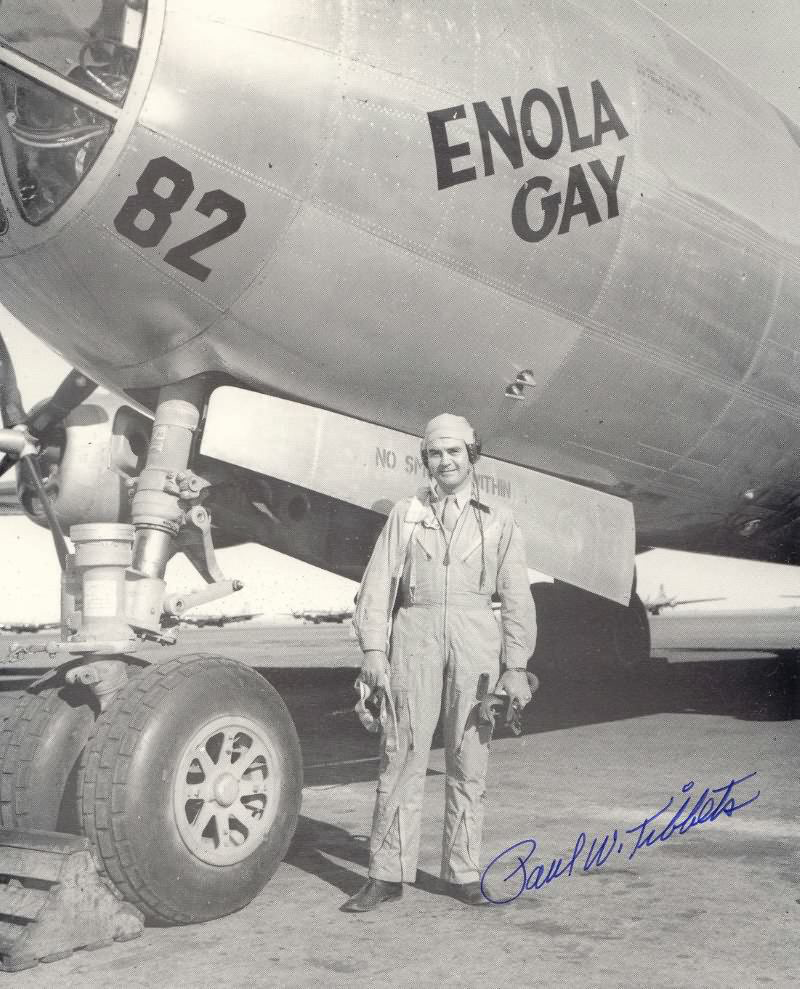
0137: The three weather planes, Straight Flush, Jabit III, and Full House, take off, each one independently assigned to assess weather conditions over Hiroshima, Kokura, and Nagasaki.
0151: Big Stink takes off to assume its stand-by role as the strike spare plane at Iwo Jima.
0220: The final Enola Gay crew photo is taken. Tibbets turns to his crew and says, “Okay, let’s go to work.”
0227: Enola Gay’s engines are started.
0235: Enola Gay arrives at her takeoff position on the runway.
0245: Enola Gay begins takeoff roll. Colonel Paul Tibbets says to co-pilot Robert Lewis, “Let’s go." He pushes all of the throttles forward. The overloaded Enola Gay lifts slowly into the night sky, using all of the more than two miles of runway.
0247: The Great Artiste takes off.
0249: Necessary Evil takes off.
0255: Ten minutes after takeoff, Dutch Van Kirk writes his initial entry in the navigator’s log.
0300: Capt. William "Deak" Parsons taps Tibbets on the shoulder, indicating that they were going to start arming Little Boy. Parsons and Morris Jeppson, the Electronic Test Officer, climb into the bomb bay.
0310: Parsons inserts the gunpowder and the detonator into Little Boy.
0320: Parsons and Jeppson complete inserting the charge into Little Boy, and climb out of the bomb bay.
0420: Van Kirk provides an estimated time of arrival over Iwo Jima of 5:52am.
0600: The B-29s rendezvous over Iwo Jima, climb to 9,300 feet, and set their course for Japan.
0715: Jeppson removes Little Boy's safety devices and inserts the arming devices (changing from green plugs to red plugs).
0730: Tibbets announces to the crew: "We are carrying the world's first atomic bomb." He pressurizes the Enola Gay and begins an ascent to 32,700 feet. The crew puts on their parachutes and flak suits.
0809: The weather planes fly over the possible target cities. In Hiroshima, an air raid alert is communicated.
0824: The pilot of the Straight Flush weather plane sends Tibbets a coded message that states: “Cloud cover less than 3/10ths at all altitudes. Advice: bomb primary." Tibbets turns on the intercom and announces, “It’s Hiroshima.” Tibbets then asks Richard Nelson to send a one word message to William L. Uanna, squadron security chief on Iwo Jima: "Primary.”
0831: The weather planes depart their locations. In Hiroshima, the all-clear is sounded.
0850: Flying at 31,000 ft, Enola Gay crosses Shikoku due east of Hiroshima. Bombing conditions are good, the aim point is easily visible, and no opposition is encountered.
0905: Van Kirk announces, “Ten minutes to the AP." The Enola Gay is at an altitude of 31,060 feet with an air speed of 200 miles an hour when the City of Hiroshima first comes into view. It is high tide in the Sea of Japan, so the seven branches of the Ota River are completely full and still. Male students are on their way to work at the munitions factory. Schoolgirls are already demolishing more buildings to create additional fire lanes.
0912: Control of the Enola Gay is handed over to the bombardier, Thomas Ferebee, as the bomb run begins. A Radio Hiroshima operator reports that three planes have been spotted.
0914: Tibbets tells his crew, “On glasses."
0914:17 (0814:17 Hiroshima time): Ferebee's aiming point, the T-shaped Aioi Bridge, is in clear range. The 60-second sequence to automatic release of the bomb is engaged with the Norden bombsight. Luis Alvarez, one of the Manhattan Project’s senior scientists aboard The Great Artiste, releases two pressure gauges on parachutes in order to determine the bomb’s yield. People on the ground, looking at the single bomber six miles above, observe the small object as it floats down.
0915:15 (8:15:15 Hiroshima time): The bomb bay doors snap open, and Little Boy drops clear of its restraining hook. Ferebee announces, "Bomb away." The nose of the Enola Gay rises ten feet as the 9,700 pound Little Boy bomb is released at 31,060 feet. Tibbets immediately pulls the Enola Gay into a sharp 155 degree turn to the right. Ferebee watches the bomb wobble before it picks up speed and falls away.
On the ground, a second air raid alert is called for. For an additional 44.4 seconds, the Enola Gay continues to flies north as the bomb drops toward its aiming point. When the designated detonation altitude is reached, Little Boy explodes over the city of Hiroshima.
At the time of the detonation, the Enola Gay is already eleven and a half miles away. Tibbets, with his back to the explosion, observes a silver blue flash and experiences a strange feeling in his mouth, the same feeling as if he touched the lead and silver fillings in his mouth with a fork.
Bob Caron, the tail gunner of the Enola Gay, is the only crew member facing Hiroshima at the time of detonation. He sees a shimmer in the atmosphere coming towards the plane. Not understanding what is happening, Caron remains quiet. Soon after, the first of the three consecutive shockwaves strike the Enola Gay and the fuselage creaks and groans with the sound of crinkling aluminum foil.
0916:02 (8:16:02 AM Hiroshima time): After falling nearly six miles in forty-three seconds, Little Boy explodes 1,968 feet above the Dr. Shima’s Clinic, 550 feet away from the aiming point of the Aioi Bridge. Nuclear fission begins in 0.15 microseconds with a single neutron, initiating a supercritical chain reaction that increases the temperature to several million degrees Fahrenheit hotter than the surface of the sun at the time the bomb casing blows apart. The yield is 12.5-18 Kt (best estimate is 15 Kt).
It is the peak of the morning rush hour in Hiroshima. Above the city, the fireball is rapidly expanding.
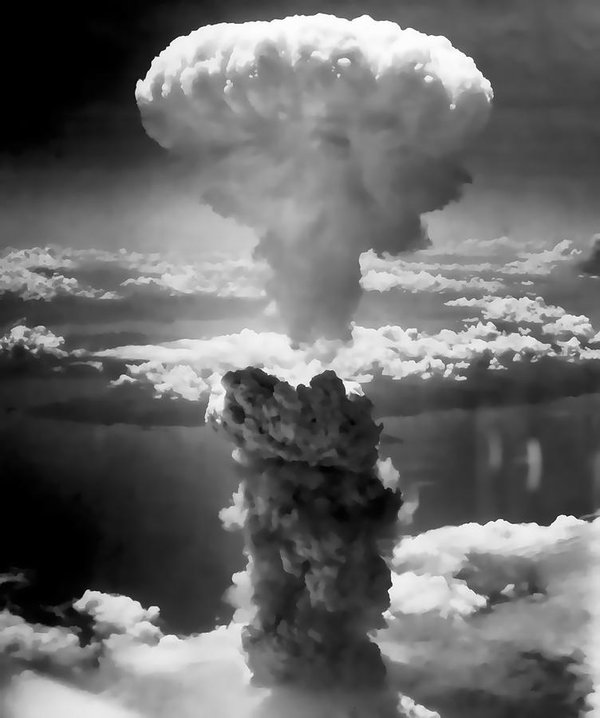
Mushroom cloud from Hiroshima bomb blast.
.1 seconds: The fireball has expanded to one hundred feet in diameter combined with a temperature of 500,000°F. Neutrons and gamma rays reach the ground. The ionizing radiation is responsible for causing the majority of the radiological damage to all exposed humans, animals and other biological organisms.
.15 seconds: The superheated air above the ground glows. A woman sitting on steps on the bank of the Ota river, a half a mile away from ground zero, instantly vaporizes.
0.2-0.3 seconds: Intense infrared energy is released and instantly burns exposed skin for miles in every direction. Building roofing tiles fuse together. A bronze Buddha statue melts, and even granite stones. Roof tiles fuse together, wooden telephone poles carbonize and become charcoal-like. The soft internal organs (viscera) of humans and animals are evaporated. The blast wave propagates outward at two miles per second or 7,200 miles per hour.
1.0 second and beyond: The fireball reaches its maximum size, approximately 900 feet in diameter. The blast wave slows to approximately the speed of sound (768 miles per hour). The temperature at ground level directly beneath the blast (hypocenter) is at 7,000° F. The mushroom cloud begins to form.
The blast wave spreads fire outward in all directions at 984 miles per hour and tears and scorches the clothing off every person in its path. The blast wave hits the mountains surrounding Hiroshima and rebounds back. Approximately 60,000 out of the city's 90,000 buildings are demolished by the intense wind and firestorm.
Approximately 525 feet southwest from the hypocenter, the copper cladding covering the dome of the Industrial Products Display Hall is gone, exposing the skeleton-like girder structure of the dome. However, most of the brick and stonework of the building remains in place.
The ground within the hypocenter cools to 5,400°F. The mushroom cloud reaches a height of approximately 2,500 feet. Shards of glass from shattered windows are imbedded everywhere, even in concrete walls. The fireball begins to dim but still retains a luminosity equivalent to ten times that of the sun at a distance of 5.5 miles.
Nuclear shadows appear for the first time as a result of the extreme thermal radiation. These shadows are outlines of humans and objects that blocked the thermal radiation. Examples are the woman who was sitting on the stairs near the bank of the Ota River. Only the shadow of where she sat remains in the concrete. The shadow of a man pulling a cart across the street is all that remains in the asphalt. The shadow of a steel valve wheel appears on a concrete wall directly behind it because the thermal radiation was blocked by the outline of the wheel.
Russell Gackenbach, the navigator aboard Necessary Evil, at a distance of 15 miles from the atomic blast, is illuminated by light so bright that, even with his protective goggles on, he could have read the fine print of his pocket Bible.
On the ground, the firestorm continues to rage within an area which had now grown to over a mile wide. A gruesome, raging red and purple mass begins to rise in the sky. The mushroom column sucks superheated air, which sets fire to everything combustible. Bob Caron likens the sight to "a peep into Hell.”
A coded message drafted by Parsons is sent to General Thomas Farrell at Tinian. It stated: “Clear cut, successful in all aspects. Visible effects greater than Alamogordo. Conditions normal in airplane following delivery. Proceeding to base."
Enola Gay circles Hiroshima a total of three times beginning at 29,200 feet and climbing towards 60,000 feet before heading for home. It was 368 miles from Hiroshima before Caron reported that the mushroom cloud was no longer visible.
0930: (0830 Hiroshima time): The Kure Navy Depot sends a message to Tokyo that a bomb has been dropped on Hiroshima.
1055: (0955 Hiroshima time): The US intercepts a message from the Japanese 12th Air Division reporting “a violent, large special-type bomb, giving the appearance of magnesium.”
1100: (1000 Hiroshima time): A message from Hiroshima to the Army Ministry references information about a new American bomb and reports that “this must be it.”
1458: Enola Gay lands in Tinian Island at the North Field. The first atomic bombing mission has lasted a total of twelve hours and thirteen minutes.
1500: (1400 Tokyo time): The Domei News Agency telegram in Tokyo reports an attack on Hiroshima, but not the magnitude of the destruction.
Evening: A senior Japanese government administrator reports enormous destruction in Hiroshima.
Japanese Casualties of the Bombing of Hiroshima
The uranium gun-type atomic bomb that was dropped on Hiroshima had an explosive blast equal to approximately 12-15,000 tons of TNT, incinerating five square miles of the city surrounding the Aioi Bridge. At the time of the bombing, Hiroshima was home to 280,000-290,000 civilians as well as 43,000 soldiers. About 80,000 were killed instantly or seriously wounded. Between 90,000 and 166,000 people are believed to have died from the bomb in the four-month period following the explosion. The U.S. Department of Energy has estimated that after five years there were perhaps 200,000 or more fatalities as a result of the bombing, while the city of Hiroshima has estimated that 237,000 people were killed directly or indirectly by the bomb's effects, including burns, radiation sickness, and cancer. Of the estimated 90,000 buildings, 62,000 were destroyed, including the elimination of all utilities and means of transportation.
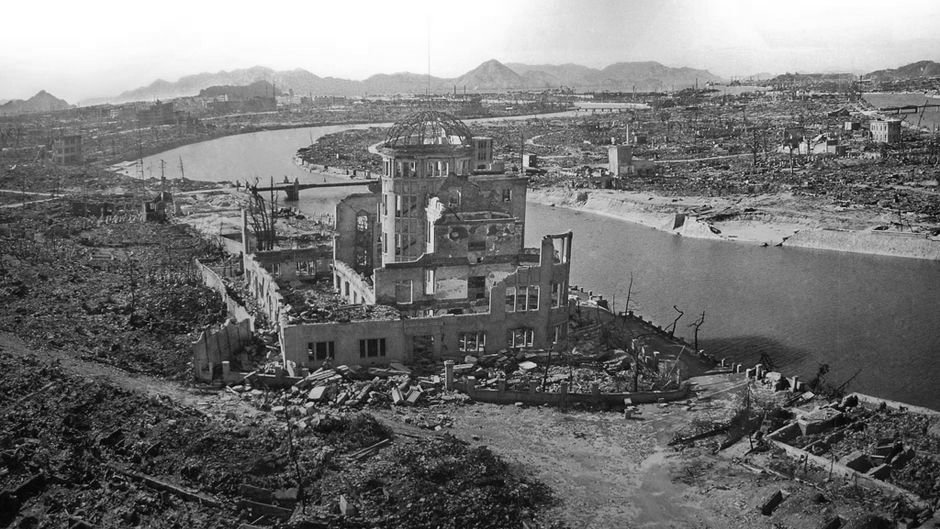
Between the Bombings
August 7:
A message to Vice Chief of the Imperial Army General Staff Torashiro Kawabe reports: “The whole city of Hiroshima was destroyed instantly by a single bomb.” Kawabe writes in his diary that he was “shocked tremendously,” but that the Imperial Army must continue to resist.
Close advisor Koichi Kido meets with Emperor Hirohito to discuss the Hiroshima bombing.
A crash effort begins to print millions of leaflets to be dropped on major Japanese cities warning of future atomic attacks.
The decision to drop the second bomb is made on Guam. The date for dropping Fat Man is moved up to August 10, then to August 9, to avoid a projected 5 days of bad weather. This requires skipping many check out procedures during assembly.
August 8:
A seven-man Imperial Army investigation team (dispatched from Tokyo and delayed by aircraft problems) arrives at Hiroshima and circles the city by plane.
Hirohito receives a report on Hiroshima from Foreign Minister Shigenori Togo, who calls for an end to the war based on the Potsdam Declaration.
At Togo's request, Soviet Ambassador Naotake Sato tries to persuade the Soviets to mediate surrender negotiations. Soviet Foreign Minister Vyacheslav Molotov informs Sato that the Soviet Union is at war with Japan effective the next day.
The Japanese government does not formally meet to discuss surrender.
Leaflet dropping and warnings to Japan by Radio Saipan begin. Nagasaki does not receive warning leaflets until August 10. Fat Man unit F33 is dropped in practice bomb run. Assembly of Fat Man unit F31 with the plutonium core is completed in the early morning. In the rush to complete the bomb, the firing unit cable was installed backwards, requiring Barney J. O'Keefe to cut the connectors and reinstall them at the very last minute.
August 9:
The Soviet Union declares war on Japan and invades Manchuria.
The Bombing of Nagasaki - August 9, 1945
[Times are in Tinian time unless otherwise noted. The time in Nagasaki is one hour earlier.]
August 8, 1400: Initial word is sent out that there would be an upcoming briefing.
2200: Fat Man is loaded on B-29 Bockscar.
2300: A pre-flight briefing is held for all crew members of the three primary planes. Rendezvous point is changed from Iwo Jima to Yakushima due to bad weather. In addition, the altitude at which the planes were to fly was raised 17,000 feet from the normal 9,000 feet. This would increase fuel consumption. Two important directives were issued by Colonel Paul Tibbets at this briefing: wait no more than fifteen minutes at the rendezvous point before proceeding on to Japan, and drop the Fat Man bomb visually.
August 9, 0215: The Bockscar crew boards the plane and performs pre-flight checks. Flight engineer John Kuharek notices the fuel pump for one of the 640 gallon reserve tanks on Bockscar is not functioning. The crew deplanes while the situation is discussed. The decision is made to carry on with the mission as planned.
0258: The two weather planes, Enola Gay and Laggin' Dragon, take off for their selected cities to monitor weather conditions.
0347: Bockscar, piloted by Major Charles Sweeney, lifts off from Tinian Island. The target of choice is Kokura Arsenal.
0351: The Great Artiste, piloted by Capt. Fred Bock, takes off.
0353: Big Stink, piloted by Major James Hopkins, takes off.
0400: Cmdr. Fred Ashworth, the weaponeer on Bockscar, enters the bomb bay and switches out the safety plugs.
0910: Bockscar reaches the rendezvous point and immediately spots The Great Artiste. Big Stink is nowhere in sight. The planes increase their altitude to 30,000 feet and slowly circle Yakushima Island. The weather planes report that both Kokura and Nagasaki have cloud cover but visibility is sufficient for visual bombing.
0950: After circling for forty minutes, Bockscar and The Great Artiste finally head in the direction of Kokura. Big Stink is nowhere to be seen. (Note: There are still to this day differing stories of why Big Stink failed to rendezvous with the rest.) The additional thirty minutes that Bockscar and The Great Artiste took to wait may have cost the mission visual bombing conditions over Kokura, possibly saving the city from the bombing and instead dooming Nagasaki.
1044: Bockscar arrives at Kokura, but finds it covered by haze. The aim point cannot be seen. Three bomb runs are made on Kokura, but each time the drop is called off. Flak and fighters appear, forcing the plane to stop searching for the aim point. Animated discussions take place amongst crew members as what to do next.
1132: The decision is made to head for the only secondary target in range, Nagasaki, 95 miles to the south. Major Charles Sweeney turns toward Nagasaki.
1156: Bockscar and The Great Artiste arrive at Nagasaki.
1158: Upon arriving at Nagasaki, Bockscar has enough fuel for only one pass over the city, even with an emergency landing at Okinawa. Nagasaki is covered with clouds, but one gap allows a drop several miles from the intended aim point. Bombardier Kermit Beahan releases Fat Man. Bockscar and The Great Artiste take a 155 degree dive to their right and left respectively.
1200: (1100 Tokyo time): The Imperial Supreme War Council meets to discuss a conditional surrender.
1202: (11:02 AM Nagasaki time): Fat Man explodes at an altitude of 1,650 feet over the city. Three shock waves are felt by both planes.
On the day of the bombing, an estimated 263,000 were in Nagasaki, including 240,000 Japanese residents, 9,000 Japanese soldiers, and 400 prisoners of war. It is estimated that between 40,000 and 75,000 people died immediately following the atomic explosion, while another 60,000 people suffered severe injuries.
The radius of total destruction from the atomic blast was about one mile, followed by fires across the northern portion of the city to two miles south of where the bomb had been dropped. In contrast to many modern aspects of Hiroshima, almost all of the buildings in Nagasaki were of old-fashioned Japanese construction, consisting of wood or wood-frame buildings with wood walls and tile roofs. Many of the smaller industries and business establishments were also situated in buildings of wood or other materials not designed to withstand explosions. As a result, the atomic explosion over Nagasaki leveled nearly every structure in the blast radius.
The failure to drop Fat Man at the precise bomb aim point caused the atomic blast to be confined to the Urakami Valley. As a consequence, a portion of the city was protected from the explosion. The Fat Man bomb was dropped over the city's industrial valley midway between the Mitsubishi Steel and Arms Works in the south and the Mitsubishi-Urakami Ordnance Works in the north. The resulting explosion had a blast yield equivalent to 21 kilotons of TNT, roughly the same as the Trinity blast. Nearly half of the city was completely destroyed.
1206: Bockscar and The Great Artiste, now low on fuel, head toward Okinawa. Real possibility exists for a forced landing in the water. Attempt to raise air/sea rescue units fails.
1230: (1130 Tokyo time): The Supreme War Council receives news of the Nagasaki bombing and continues to debate.
1300: Okinawa is in sight. Attempts to notify airfield of emergency landing fail. There are other planes landing at the time on the only active runway. Finally, Sweeney orders flares to be fired and Bockscar heads in. They land at 150 MPH instead of the normal 120 MPH. The number 2 engine runs out of fuel as they are on the runway.
1320: Both The Great Artiste and Big Stink land at Okinawa. Big Stink had made its way to Nagasaki and arrived in time to take photographs of the bombing.
1730: Bockscar, The Great Artiste, and Big Stink take off from Okinawa for Tinian Island.
2230: The planes arrive back at North Field on Tinian. Unlike after the Hiroshima mission, no one was waiting to greet them or for photo ops.
Japanese Casualties of the Bombing of Nagasaki
On the day of the bombing, an estimated 263,000 were in Nagasaki, including 240,000 Japanese residents, 9,000 Japanese soldiers, and 400 prisoners of war. Prior to August 9, Nagasaki had been the target of small-scale bombing by the United States. Though the damage from these bombings was relatively small, it created considerable concern in Nagasaki and many people were evacuated to rural areas for safety, thus reducing the population in the city at the time of the nuclear attack. It is estimated that between 40,000 and 75,000 people died immediately following the atomic explosion, while another 60,000 people suffered severe injuries. Total deaths by the end of 1945 may have reached 80,000.
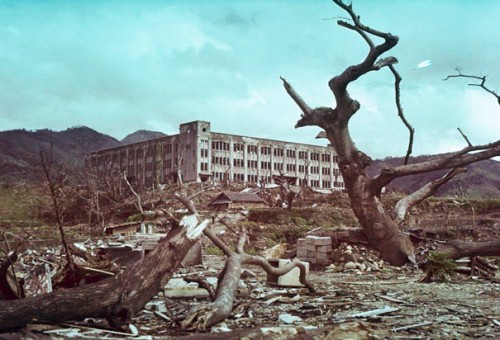
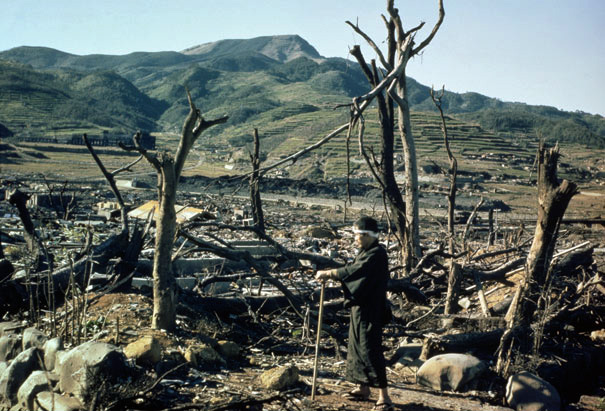
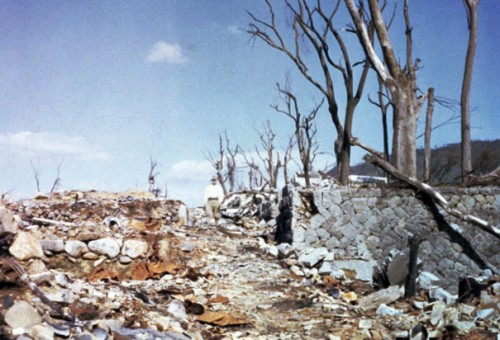
Aftermath
August 9:
J. Robert Oppenheimer cables General Leslie Groves with the following shipping schedule for more atomic bombs: 11 Aug. first quality HE unit; 12 Aug. next plutonium core; 14 Aug. another first quality HE unit.
August 10:
The Imperial Army investigation team reports on the bombing of Hiroshima. Japanese civilian and military leaders are still unable to agree on accepting the Potsdam Declaration's surrender terms. Hirohito instead breaks the tradition of imperial non-intervention in government and makes his “sacred decision” to accept the Potsdam Declaration, but under the condition that the Emperor remain sovereign. The cabinet remains divided.
Defying the wishes of military officials, the Domei News Agency sends a message to the Allies using Morse code: “Japan Accepts Potsdam Proclamation.” The United States begins broadcasting information that Japan had surrendered.
General Groves reports that the second plutonium core would be ready for shipment on August 12 or 13, with a bombing possible on August 17 or 18. President Truman orders a halt to further atomic bombing until further orders are issued.
August 11:
U.S. Secretary of State James Byrnes rejects Japan’s conditional surrender. His message states, “From the moment of surrender the authority of the emperor and the Japanese Government to rule the state shall be subject to the Supreme Commander of the Allied Powers” while “the ultimate form of government of Japan shall be established by the freely expressed will of the Japanese people.” Hirohito’s postwar position is left ambiguous.
General Groves decides to delay shipping the second plutonium core and contacts Robert Bacher just after he had signed receipt for shipping the core to Tinian Island. The core is retrieved from the car before it leaves Los Alamos, NM.
General Carl Spaatz orders a halt of area firebombing, but other attacks continue.
August 12:
Hirohito decides to accept the Byrnes Note and unconditional surrender. He informs the Imperial family of his decision.
August 13:
The Supreme War Council meets to discuss a response to the Byrnes Note.
Hirohito orders the suspension of all military activity.
A small group of Japanese military officials plot a coup against Hirohito.
Secretary of War Henry Stimson recommends shipping the second plutonium core to Tinian Island, but no decision is made.
President Truman orders area firebombing resumed. Gen. Henry Arnold, US Army Air Force, launches a raid with over 1000 B-29s and other aircraft, carrying 6000 tons of bombs. Thousands of Japanese are killed by August 14.
August 14:
With rumors of a coup and his generals still divided, Hirohito calls together the Supreme War Council and his cabinet to announce his decision of unconditional surrender.
Major Kenji Hatanaka and Lieutenant Colonel Jiro Shiizaki lead a group of junior officers who try to seize the Imperial Palace and impose martial law, but they fail to gain the support of senior officials.
The cabinet approves a message of surrender that Japan intends to accept the Potsdam Declaration unconditionally and sends it to the Allies.
August 15:
The coup fails. Hatanaka, Shiizaki, and others commit ritual suicide on the grounds of the Imperial Palace.
Hirohito announces the decision to surrender over the radio. For many Japanese, it is their first time hearing the Emperor's voice.
September 2:
Japanese officials sign the formal Japanese Instrument of Surrender on board the USS Missouri.
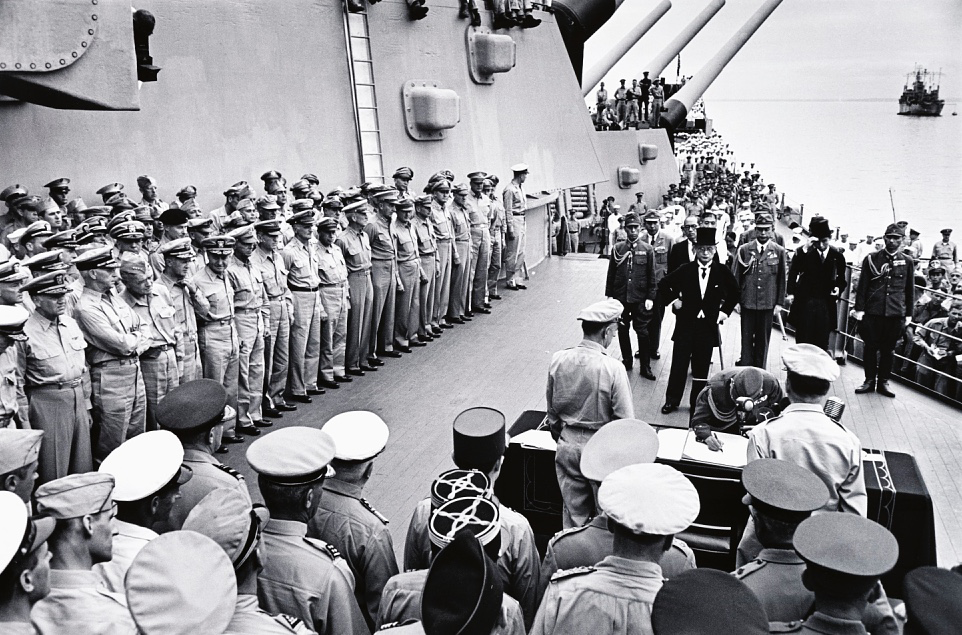
Source: Atomic Heritage Foundation, Bombings of Hiroshima and Nagasaki, April 26, 2016

